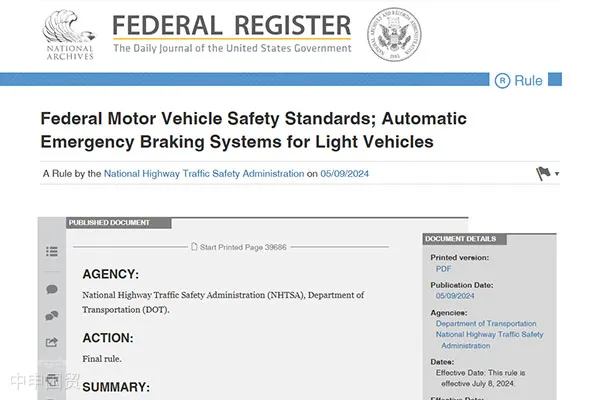- Shanghai Zhongshen International Trade Co., Ltd. - Two decades of trade agency expertise.
- Service Hotline: 139 1787 2118
On May 9, 2024, the US National Highway Traffic Safety Administration (NHTSA) issued a final rule notification establishing Federal Motor Vehicle Safety Standards for light vehicle automatic emergency braking (AEB) systems. The rule aims to improve road safety by standardizing AEB system requirements. It will take effect on July 8, 2024, with compliance requirements implemented by September 1, 2029. Small-volume manufacturers or final-stage manufacturers of phased production vehicles must comply by September 1, 2030. This article details the rules four key requirements and their impact on relevant companies.
一、AEB系統要求
Vehicles equipped with AEB systems
Under the final rule, all light vehicles must be equipped with AEB systems capable of providing forward collision warnings to drivers via audio-visual alerts when speeds range between 10 km/h and 145 km/h. The warning system components must meet clear requirements to ensure timely and effective communication. This regulation aims to reduce collisions by alerting drivers who fail to detect hazards in time.
1.2 Automatic Braking Function
The AEB system not only provides collision warnings but also performs automatic braking in two specific scenarios. When the vehicle speed is between 10km/h and 145km/h and about to collide with the vehicle ahead, or when the speed is between 10km/h and 73km/h and about to collide with a pedestrian, the AEB system should automatically execute emergency braking. This regulation aims to reduce rear-end collisions and pedestrian accidents, enhancing overall road safety.
II. AEB System Testing Procedures
2.1 Test Procedure Standards
The new safety standards clarify the test procedures for AEB systems, requiring the system to prevent collisions with test vehicles or pedestrian test equipment. The test procedures provide clear definitions of parameters, including driving speed and test scenarios. For example, there are three scenarios for front-vehicle collision tests at 100km/h and four scenarios for pedestrian collision tests. These rigorous standards ensure the AEB system functions effectively under various real-world road conditions.
2.2 False Activation Testing
The rules include two false activation tests: one where the vehicle drives over a steel trough plate, and another where it passes between two parallel parked vehicles. In these scenarios, the AEB system must not engage the brakes beyond a specific allowable threshold. This regulation prevents false activations in non-emergency situations, ensuring normal driving operations are not disrupted.
III. AEB System Fault Detection
3.1 Continuous Monitoring and Notification Function
Vehicles must continuously monitor the AEB system for faults, including performance degradation due to sensor obstructions. In case of system failure, drivers must be notified that the AEB system cannot meet the minimum performance requirements. This ensures drivers are promptly informed and can take appropriate measures to avoid safety risks caused by system malfunctions.
3.2 Maintenance and Servicing
Relevant companies must develop detailed maintenance and servicing plans to ensure the AEB system operates normally. Regular inspections and maintenance of key components such as sensors and control units are required to eliminate potential faults, guaranteeing the systems reliability and stability throughout the vehicles lifespan.
IV. Impact on Exporting Companies and Response Measures
4.1 Tracking and Research on Technical Regulations
Customs reminds export-related companies to strengthen their tracking and research on foreign technical regulations and standards, staying updated on the latest requirements. This not only helps companies respond quickly to regulatory changes but also gives them a competitive edge in the market. In particular, companies should promptly follow up on new standards regarding front-vehicle and pedestrian collision test scenarios and update their testing plans to ensure compliance with the latest safety standards.
4.2 Proactive Measures
Export companies need to take proactive measures to enhance product safety. On one hand, they can improve AEB system performance through technical upgrades and refinements. On the other hand, they can collaborate with international professional testing agencies to ensure products pass strict certification tests before export, meeting the safety standards of importing countries.
NHTSAs new regulations undoubtedly play a significant role in improving road safety. Relevant companies must promptly understand and comply with these standards to ensure product compliance and market competitiveness. We hope this article provides valuable insights to help companies achieve greater success in a competitive market.

Original Announcement:Federal Motor Vehicle Safety Standards; Automatic Emergency Braking Systems for Light Vehicles
Related Recommendations
? 2025. All Rights Reserved. 滬ICP備2023007705號-2  PSB Record: Shanghai No.31011502009912
PSB Record: Shanghai No.31011502009912










